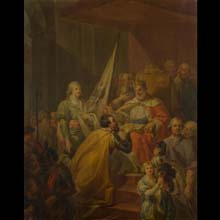
material: oil on canvas
dimensions: 66 x 52 cm
description: The act of the Prussian homage to the king of Poland, Sigismund I, was performed in the Market Square in Krakow, on April 10, 1525 by Albrecht Hohenzollern, who, after the secularization of the Teutonic Order, became the secular duke of the newly established Duchy of Prussia. Sigismund I, with the Order of the Golden Fleece on his neck, is listening to Hohenzollern’s oath sworn on the Bible. Next to them, a young man is holding a feudal banner, which, according to historical sources, should depict a black eagle against a white background, with the royal crown on its neck and the letter “S” (from the Latin equivalent of the king’s name – Sigismundus) on its chest. However, Bacciarelli, still insensitive to historical details, inaccurately depicted the coat of arms of Royal Prussia on the banner – an eagle with a crown and the hand of a knight holding a broadsword. The painter did not set the scene in the Market Square in Krakow, as it was later done by Matejko, but in a Barque interior. Although the artist did not paint the clothes of the day, he tried to divide them into “Polish,” worn by most of the participants, and “foreign,” which the Teutonic Knights are dressed in. It is worthy of note that the clergyman standing on the right was modelled after the eminent historian and collaborator of the king, Adam Naruszewicz. Barbara Ciciora
exposition: The Gallery of 19th Century Polish Art in Sukiennice,
The Cloth Hall, 1, Main Market Square
key: Enlightenment >>>
dimensions: 66 x 52 cm
description: The act of the Prussian homage to the king of Poland, Sigismund I, was performed in the Market Square in Krakow, on April 10, 1525 by Albrecht Hohenzollern, who, after the secularization of the Teutonic Order, became the secular duke of the newly established Duchy of Prussia. Sigismund I, with the Order of the Golden Fleece on his neck, is listening to Hohenzollern’s oath sworn on the Bible. Next to them, a young man is holding a feudal banner, which, according to historical sources, should depict a black eagle against a white background, with the royal crown on its neck and the letter “S” (from the Latin equivalent of the king’s name – Sigismundus) on its chest. However, Bacciarelli, still insensitive to historical details, inaccurately depicted the coat of arms of Royal Prussia on the banner – an eagle with a crown and the hand of a knight holding a broadsword. The painter did not set the scene in the Market Square in Krakow, as it was later done by Matejko, but in a Barque interior. Although the artist did not paint the clothes of the day, he tried to divide them into “Polish,” worn by most of the participants, and “foreign,” which the Teutonic Knights are dressed in. It is worthy of note that the clergyman standing on the right was modelled after the eminent historian and collaborator of the king, Adam Naruszewicz. Barbara Ciciora
exposition: The Gallery of 19th Century Polish Art in Sukiennice,
The Cloth Hall, 1, Main Market Square
key: Enlightenment >>>












